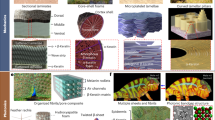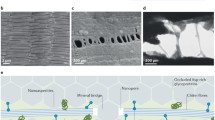Abstract
Biological hard tissues are composites of inorganics and biopolymers, and, therefore, represent hybrid systems. The inorganic components may be oxides (e.g., SiO2, Fe3O4), carbonates (e.g., CaCO3) sulfides (e.g., FeS, CdS), or others, mostly in crystalline forms but also occasionally in glassy forms. The biopolymer is often proteinaceous, but can also involve lipids and especially polysaccharides (e.g., chitin). These hybrid materials can be found in single celled organisms (such as bacteria and protozoa), invertebrates (such as mollusks), insects (such as beetles), and vertebrates (such as mammals). A common denominator of all hard tissues is that they are hierarchically structured from the nanometer scale to the microscale and the macroscale. It is these controlled structures that give biological hard tissues their unique and highly evolved functional properties. The engineering properties include mechanical, piezoelectric, optical, and magnetic. The hard tissues can be in the form of nanoparticles, spines, spicules, skeletons, and shells. The objective of this paper is to demonstrate mechanical aspects of some of these hard tissues, to discuss their structure-function relationships (with examples from the literature as well as from our research), and to reveal their potential utility in materials science and engineering applications.
Similar content being viewed by others
References
Lowenstam, H.A., “Biominerals,”Science,211,1126–1131 (1981).
Simkiss, K., andWilbur, K.M., “Biomineralization,”New York:Academic Press (1989).
Wainwright, S.A., Biggs, W.D., Currey, J.D., andGosline, J.M., “Mechanical Design in Organisms,”Princeton, NJ:Princeton University Press (1982).
Sarikaya, M., andAksay, I.A., “Biomimetics: Design and Processing of Materials,”38–90, American Institute of Physics, New York (1996).
National Materials Advisory Board, Committee on Hierarchical Structures, “Hierarchical Structures in Biology as a Guide for New Materials Technology,”NMAB-464,62,Washington, DC:National Academy Press (1994).
Vincent, J.F.V., “Structural Biomaterial”revised ed., Princeton, NJ:Princeton University Press (1990).
Currey, J.D., “Mechanical Properties of Mollusk Shell,”in Symposia of the Society for Experimental Biology, Vol. XXXIV. The Mechanical Properties of Biological Materials, 77, London, UK:Cambridge University Press (1980).
Sarikaya, M., andAksay, I.A., “Mother-of-Pearl: Structure, Mechanical Properties, and Formation,”Biopolymers,1,1–25 (1992).
Jackson, A.P., Vincent, J.F.V., andTurner, R.M., “Comparison of Nacre with Other Ceramic Composites,”J. Mater. Sci.,25,3173–3185 (1990).
Jackson, A.P., Vincent, J.F.V., andTurner, R.M., “The Mechanical Design of Nacre,”Proc. R. Soc. B,234,415–430 (1988).
Menig, R., Meyers, M.H., Meyers, M.A., andVecchio, K.S., “Quasistatic and Dynamic Mechanical Response of Haliotis Rufescens (Red Abalone) Shells,”Acta Mater.,48,2383–2398 (2000).
Wang, R.Z., et al., “Deformation Mechanisms in Nacre,”J. Mater. Res.,16,2485–2493 (2001).
Evans, A.G., et al., “Model for the Robust Mechanical Behavior of Nacre,”J. Mater. Res.,16,2475–2484 (2001).
“Engineered Materials Handbook,” 417, ASM International, Metals Park, OH (1995).
Kamat, S., Su, X., Ballarini, R., andHeuer, A.H., “Structural Basis for the Fracture Toughness of the Shell of the Conch,”Nature,405,1036–1040 (2000).
Sarikaya, M., et al., “Biomimetic Model of a Sponge-Spicular Optical Fiber-Mechanical Properties and Structure,”J. Mater. Res.,16,1420–1428 (2001).
Kelly, A., andDavies, G.J., “The Principles of Fiber Reinforcement of Metals,”Metall. Rev.,10,12 (1965).
Broutman, L.J., andKrock, R.H., “Modern Composite Materials,”13, Reading, MA:Addison-Wesley (1967).
Jones, R.M., “Mechanics of Composite Materials,”Washington, DC:Scripta Book Co. (1975).
Lee, S., Wadsworth, J., andSherby, O.D., “Tensile Properties of Laminated Composites Based on Ultrahigh Carbon Steel,”J. Comput. Mater.,25,842–853 (1991).
Ker, R.F., “Some Structural and Mechanical Properties of Locust and Beetle Cuticle,”D. Phil. Thesis, Oxford, UK:University of Oxford (1977).
Padawer, G.E., andBeecher, N., “On the Strength and Stiffness of Planar Reinforced Plastic Resins,”Polym. Eng. Sci.,10,185 (1970).
Riley, V.R., “Fibre-Fibre Interaction,”J. Comput. Mater.,2,436 (1968).
Ashton, J.E., Halpin, J.C., andPetit, P.H., “Primer on Composite Materials: Analysis,”Westport, CN:Technomic Press (1969).
Hull, D., “An Introduction to Composite Materials,”London:Cambridge University Press (1981).
Staab, G.H., “Laminar Composites,”Butterworth-Heinemann, Woburn, MA (1999).
Gunderson, S.L., and Whitney, J.M., “Analysis of a Composite Laminate Having a Novel Unsymmetrical Ply Orientation,” Proc. 6th Technical Conf., Lancaster, PA, 309–318, American Society of Composites (1991).
Gunderson, S.L., andWhitney, J.M., “A Controlled Unsymmetrical Orientation for Improved Isotropic Properties,”in Advances in Composite Mechanics and Biomimetics, Proc. ASME Winter Meeting, AD29/AMD146, 99–109, ASME, New York (1992).
Gibson, L.J., andAshby, M.F., “Cellular Solids: Structure and Properties,”17,Oxford, UK:Pergamon Press (1988).
Schwartz, D.S., Shih, D.S., Evans, A.G., andWadley, H.N.G. (eds), “Porous and Cellular Materials for Structural Applications,”Proc. MRS Symposium, vol. 521, Materials Research Society, Warrendale, PA (1998).
Frisch, K.C., andSaunders, J.H. (eds), “Plastic Foams,”M. Dekker, New York (1973).
Vincent, J.F.V., “Nuts”in Proc. MRS Symposium,292,35–43,Materials Research Society,Warrendale, PA (1993).
Thompson, D.W., “On Growth and Form,”new ed., 981, Cambridge, UK:Cambridge University Press (1942).
Fong, H., Sarikaya, M., White, S.N., andSnead, M.L., “Nonomechanical Properties Profiles across DEJ of Human Incisor Tooth,”J. Mater. Sci. Eng., C,7,119–128 (2000).
Author information
Authors and Affiliations
Rights and permissions
About this article
Cite this article
Mayer, G., Sarikaya, M. Rigid biological composite materials: Structural examples for biomimetic design. Experimental Mechanics 42, 395–403 (2002). https://doi.org/10.1007/BF02412144
Received:
Revised:
Issue Date:
DOI: https://doi.org/10.1007/BF02412144




